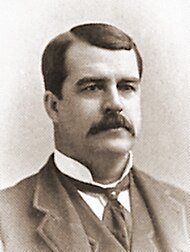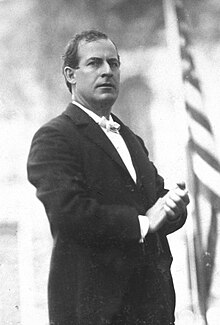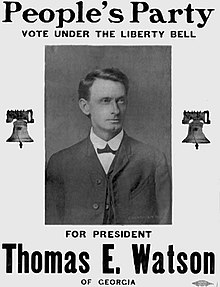People's Party (United States)
Other Populist-endorsed measures included bimetallism, a graduated income tax, direct election of Senators, a shorter workweek, and the establishment of a postal savings system.These measures were collectively designed to curb the influence of monopolistic corporate and financial interests and empower small businesses, farmers and laborers.[7] Despite fierce partisan rivalries, the two major parties were both closely allied with business interests and supported largely similar economic policies, including the gold standard.At the same time, the Farmer's Alliance became increasingly politicized, with members attacking the "money trust" as the source and beneficiary of both the crop lien system and deflation.[20] The movement began to expand into the Northeast and the Great Lakes region, while Macune led the establishment of the National Reform Press Association, a network of newspapers sympathetic to the Farmer's Alliance.[26] Among those who favored the establishment of a third party were Farmer's Alliance president Leonidas L. Polk, Georgia newspaper editor Thomas E. Watson, and former Congressman Ignatius L. Donnelly of Minnesota.Delivering the final speech of the convention, Ignatius L. Donnelly, stated, "We meet in the midst of a nation brought to the verge of moral, political, and material ruin."[29] Following Donnelly's speech, delegates agreed to establish the People's Party and hold a presidential nominating convention on July 4 in Omaha, Nebraska.[34] The platform also called for a graduated income tax, direct election of Senators, a shorter workweek, restrictions on immigration to the United States, and public ownership of railroads and communication lines.[36] In the Rocky Mountains, Populist voters were motivated by support for free silver (bimetallism), opposition to the power of railroads, and clashes with large landowners over water rights.In the latter regions, the Populists received the support of union officials like Knights of Labor leader Terrence Powderly and railroad organizer Eugene V. Debs, as well as author Edward Bellamy's Nationalist Clubs.Corporate leaders had largely been successful in preventing labor from organizing politically and economically, and union membership did not rival that of the Farmer's Alliance.[42] In the 1892 presidential election, Democratic nominee Grover Cleveland, a strong supporter of the gold standard, defeated incumbent Republican President Benjamin Harrison.[citation needed] The Populists performed strongly in the West, but many party leaders were disappointed by the results in parts of the South and the entire Great Lakes Region."[48] Partly due to the growing popularity of the Populist movement, the Democratic Congress included a provision to re-implement a federal income tax in the 1894 Wilson–Gorman Tariff Act.[53] The Populists became increasingly polarized between moderate "fusionists" like Taubeneck and radical "mid-roaders" (named for their desire to take a middle road between Democrats and Republicans) like Tom Watson.[55] The mid-roaders believed that free silver did not represent serious economic reform, and continued to call for government ownership of railroads, major changes to the financial system, and resistance to the influence of large corporations.[65] Historian Hasia Diner says: In the lead-up to the 1896 presidential election, mid-roaders, fusionists, and free silver Democrats all maneuvered to put their favored candidates in the best position to win.[67] Mid-roaders mobilized to defeat the fusionists; the Southern Mercury urged readers to nominate convention delegates who would "support the Omaha Platform in its entirety.[76] Watson, ostensibly Bryan's running mate, campaigned on a platform of "Straight Populism" and frequently attacked Sewall as an agent for "the banks and railroads."Historians believe his defeat was partly attributable to the tactics Bryan used; he had aggressively "run" for president, while traditional candidates would use "front porch campaigns.Tennessee's Populist Party was demoralized by a diminishing membership, and puzzled and split by the dilemma of whether to fight the state-level enemy (the Democrats) or the national foe (the Republicans and Wall Street).Hofstadter noted that leading progressives like Theodore Roosevelt, Robert La Follette Sr., George Norris and Woodrow Wilson were vehement enemies of Populism, though Bryan cooperated with them and accepted the Populist nomination in 1896.Reichley argues that, while the Populist Party was founded in reaction to economic hardship, by the mid-1890s it was "reacting not simply against the money power but against the whole world of cities and alien customs and loose living they felt was challenging the agrarian way of life.The Populists sought diffusion of scientific and technical knowledge, formed highly centralized organizations, launched large-scale incorporated businesses, and pressed for an array of state-centered reforms.A large section of the labor movement looked to Populism for answers, forging a political coalition with farmers that gave impetus to the regulatory state.[93][page needed] Populist voters remained active in the electorate long after 1896, but historians continue to debate which party, if any, absorbed the largest share of them.[96] Michael Kazin's The Populist Persuasion (1995) argues that Populism reflected a rhetorical style that manifested itself in spokesmen like Father Charles Coughlin in the 1930s and Governor George Wallace in the 1960s.In general, many of the demands of Populists were eventually realised by later movements, including leaving the gold standard, a secret ballot, women's suffrage, an income tax, an eight-hour workday, and farm programs.Politicians as diverse as independent left-wing Senator Bernie Sanders of Vermont and Republican President Donald Trump have been labeled populists.






People's Party (Utah)People's Party (United States, 1971)People's Party (United States, 2017)LeaderJames B. WeaverThomas E. WatsonFarmers' AllianceGreenback PartyUnion Labor PartyAnti-Monopoly PartyNationalist ClubsUnited Labor Party of New YorkDemocratic PartySocialist Party of AmericaIdeologyAgrarianismBimetallismCooperativismPopulismRadicalismProgressivismPolitical positionLeft-wingPolitics of United StatesPolitical partiesElectionsagrarianpopulist1896 United States presidential electionrump factionGilded Agefiat money1890 electionsthird party1892 electionsOcala Demandsincome taxdirect election of Senatorspostal savings system1892 presidential electionJames G. FieldAmerican Civil Warelectoral votesEugene V. DebsTerence V. PowderlyMidwestNortheast1896 presidential electionMary Elizabeth Lease1896 Democratic National ConventionWilliam Jennings BryanWilliam McKinleynativistprogressivesanti-establishmentleft–right political spectrumFarmers' movementEdward Kelloggmonetary policygold standardGreenbacksCoinage Act of 1873Alexander Campbellcentral bankNorthernersRepublican PartySoutherners1880 presidential electionLampasas, Texascrop-lien systemKnights of LaborGreat Southwest railroad strike of 1886Cleburne DemandsGrover ClevelandGreat PlainsCharles MacuneNational EconomistSt. LouisGreat Lakes regionColumbus, NebraskaJohn P. BuchananLeonidas L. PolkIgnatius L. DonnellyJames WeaverEdward BellamyHenry GeorgeProhibition PartyLabor Reform PartyUnited Labor Partypresidential nominating conventionOmaha, NebraskaConfederateparty platformOmaha Platformimmigration to the United Statesfree silverLinda SlaughterDakota TerritoryTerrence PowderlyAmerican Federation of LaborBenjamin HarrisonColoradoKansasNevadaOregonNorth Dakota1872 electionMason–Dixon lineSecond presidency of Grover ClevelandPanic of 1893Sherman Silver Purchase ActWilson–Gorman Tariff ActJ. P. MorganCoxey's ArmyWashington, D.C.Silver PartySilver Republican PartyDavis Hanson WaiteCripple Creek miners' strike of 1894William V. Allen1894 electionsHerman TaubeneckTrojan HorseFusionism in North CarolinaColored AllianceMarion Butler